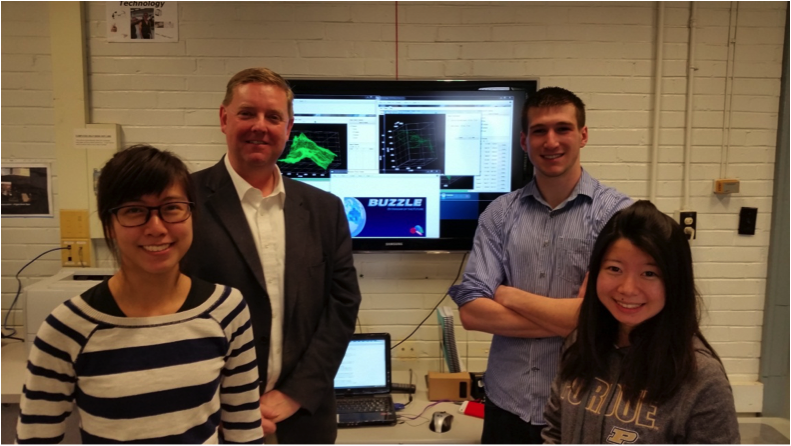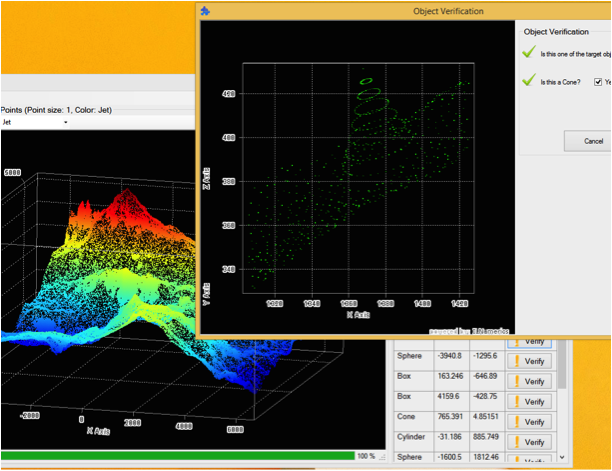Goals of the project
Hangar of the Future Research Laboratory is a technology R&D arm of the Aerospace and MRO Technology Innovation Center being established in Purdue University’s Department of Aviation Technology. The lab engages students in highly collaborative, STEM-based design-build-test projects related to real world challenges faced by aerospace and air transportation industries. Students work in diverse, cross-disciplinary teams where they are challenged in the art and science of rapid research, development and deployment of novel, human-friendly technology solutions for modern aerospace operations.
In February 2015, an undergraduate Hangar of the Future R&D team were national co-winners of Boeing’s Information Technology Case competition. The challenge was to design and deploy a software application (they named Buzzle) capable of identifying and distinguishing man-made objects (like a cube, a sphere or a cylinder) from normal topography objects like rocks and trees.
Using Light Detection and Ranging (LIDAR) point cloud data supplied by the competition sponsor (representing just millions of individual data points), the challenge was to accurately locate and identify these various objects scattered across a simulated mountainous terrain under any weather/visibility conditions. The application had to be intuitive, user-friendly and demonstrate high reliability for detecting objects correctly.
Nature of the Collaboration
This was a collaborative project among undergraduate students from Aviation Technology and the School of Aeronautics and Astronautics. It had a very short deliverable timeframe. It forced the team to set stretch goals in which their time management, willingness to defer personal preferences to fact-based design requirements and managing obstacles that threatened success were a constant part of the project. They very quickly learned the necessity of trust, perseverance and dependability. What they achieved demonstrates the very real possibilities when you don’t give up and learn from each other.
Skills
Skills utilized throughout the project included: coding (application design, construction, testing), visualization and storyboarding design requirements, learning about advanced technologies involved through research and literature review.
Tools
The tools utilized were computer based assets that included software programming, as well as testing and knowledge in areas of model based graphic design such as CATIA.
Process
The process of this particular project was driven by the design and final performance outcome requirement set by Boeing, the sponsor of the competition. The process began by establishing a research charter document identifying problem statement and key deliverables and a capabilities milestone list. This evolved by following a model similar to the Analyze, Design, Develop, Implementation and Evaluate (ADDIE) model.
Milestones
Major milestones included design requirements identification, creation of a project charter/roadmap with deliverable update and demonstration dates, initial concept design, functional design and final product testing.
Challenges encountered
Each of the four approaches tested had significant challenges in converting over 5 million data points into dimensional data that could be recognized by the software, detecting characteristic patterns then converted this data into meaningful user visualization. Very complex programming for recognizing patterns is involved. So the sheer magnitude of development time and testing involved was a continuous threat to meeting critical project deadlines.
During the process of concept reduction (selecting the best design path) tough decisions were required. One solution path was easily repeatable and predictable. However it only recognized objects accurately 75% of the time, well below the team’s established requirements. Thus a more labor intensive design path was selected because of a higher accuracy result.
This experience alone was a key learning point for the entire team. They expressed a new appreciation for tenacity, time and dedication above and beyond normal working hours sometimes required to meet challenges as true makers and pioneers; and the tremendous payoff for that kind of personal sacrifice and investment.
Major outcomes
The Buzzle project resulted in student team development of software for computational and visual analysis of large amounts of cloud data generated by point cloud systems such as Light Detection And Ranging (LIDAR) systems. When the application is opened, data is extracted and evaluated, then rendered into a visual human recognizable format. Perhaps just as important, it generated forward thinking among other student R&D teams for applying the technology into other areas of the aerospace advanced manufacturing/air transportation industry.
Innovations, impact and successes
The design process gave rise to innovative cross-over applications to other Hangar of the Future R&D projects including data point scanning for locating high value inventory parts control in aerospace manufacturing or maintenance and repair operations, and related “dwell points” along the aerospace inventory supply chain.
Because of the constraints of this project, the pattern algorithm was not developed as fully autonomous as the team desired. Given more time to develop this application, focus would continue on maximizing the pattern identification algorithm, raising accuracy to levels consistently greater than or equal to 90%. Additionally, a new feature would be added so that users could upload any CAD file to the application, and the program would be able to
search for that object in the terrain. With these two new features the application would be able to identify more objects in a wider variety of field of cloud data.
 Joelle Chia
Joelle Chia
 Deng Yun (Keryse)
Deng Yun (Keryse)
 Steven Pugia
Steven Pugia
 Timothy Ropp
Timothy Ropp

